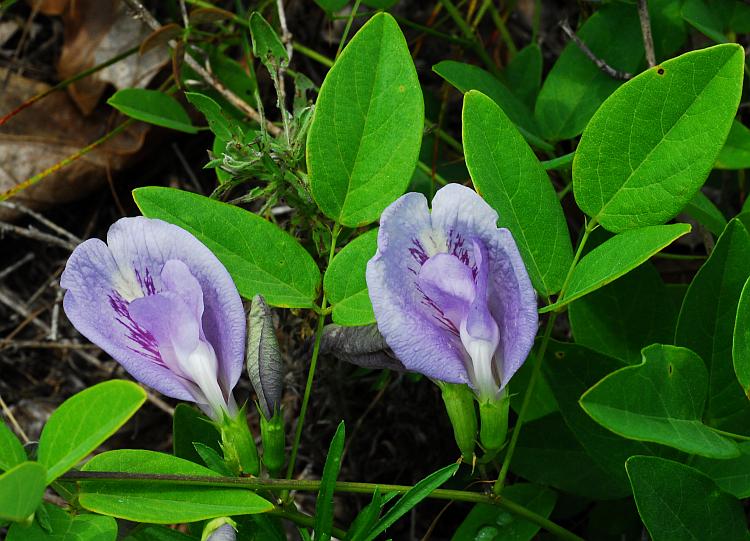Clitoria mariana L.
Butterfly Pea

Native
CC = 7
CW = 5
MOC = 23
© SRTurner
Clitoria mariana L.Butterfly Pea | |
 |
Native CC = 7 CW = 5 MOC = 23 |
© SRTurner |
|
Family - Fabaceae/Faboideae Habit - Perennial taprooted forb. Stems - Erect to reclining or trailing, to 1.2 m, glabrous to sparsely pubescent with short, fine, curved hairs.
Leaves - Alternate, pinnately trifoliate, stipulate. Petioles 1.0-4.5 cm long (the uppermost leaves occasionally nearly sessile), glabrous or sparsely short-hairy, the pulvinus to 2 mm long. Stipules 2-5 mm long, narrowly lanceolate to lanceolate, acute, with prominent parallel venation, sparsely hairy on margins; stipels 2-4 mm long, linear to hairlike, persistent. Leaflets 2-7 cm long, 1-4 cm wide, lanceolate to ovate or occasionally obovate, rounded at the base, angled to a bluntly or more commonly sharply pointed tip, the margins entire, the upper surface glabrous, the undersurface glabrous or finely pubescent with short, curved hairs along the main veins, pinnately veined, the undersurface lacking a noticeable network of veins. Terminal leaflet with the stalk 10-20 mm long, symmetric at the base; lateral leaflets essentially sessile above the pulvinus, often slightly asymmetric at the base.
Inflorescence - Axillary, solitary flowers or small clusters of 2-3 flowers, the inflorescence stalk 0.5-3.0 cm long, glabrous or sparsely and finely hairy, the bracts 1-3 mm long, linear to narrowly lanceolate, mostly shed early; bractlets 3-7 mm long, lanceolate, closely subtending the flowers, but not obscuring the calyx, persistent. Flowers - mostly opening, with some cleistogamous flowers occasionally produced on the same or different plants, twisted at the base so that the banner is oriented downward at maturity. Calyces 14-21 mm long (6-9 mm in cleistogamous flowers), 5-lobed, the tube cylindric to narrowly bell-shaped, slightly pouched on 1 side at the base, glabrous, the lobes about 1/2 as long as the tube, more or less equal, lanceolate to ovate, tapered to sharply pointed tips. Corollas papilionaceous, pinkish purple or pale purple. Banner petal with a whitish region and irregular darker purple lines toward the center, 45-50 mm long, 25-40 mm wide, the expanded portion broadly obovate to nearly circular, shallowly notched at the tip, often with a shallow longitudinal keel, the margins flat to slightly curled backward. Wing petals 32-37 mm long, 9-11 mm wide, the expanded portion oblanceolate to oblong, more or less straight to somewhat spreading from the keel, but fused to it toward the base. Keel petal 25-28 mm long, 5-6 mm wide, curved downward, fused to the usually bluntly pointed tip. Corollas of cleistogamous flowers essentially lacking. Stamens 10, all of similar length, 9 of the filaments fused and 1 free, the fused portion 22-24 mm long (essentially absent in cleistogamous flowers), the free portion 2-3 mm long, the anthers small, attached near the midpoint. Ovary in open flowers 14-17 mm long (4-6 mm in cleistogamous flowers), densely pubescent with minute, somewhat hooked hairs, the style 14-16 mm long (4-6 mm in cleistogamous flowers), minutely hairy, the stigma appearing expanded and fringed.
Fruits - Legumes, 2-6 cm long, 5-8 mm wide, narrowly oblong, straight, tapered at the tip to an elongate (15-18 mm), curved beak, flattened and slightly indented between the seeds, lacking a longitudinal ridge near each margin, leathery, glabrous at maturity, dehiscing by 2 valves, these green to tan at maturity, twisting spirally after dehiscence, with 3-10 seeds (often only 1-3 from cleistogamous flowers). Seeds 4.0-4.5 mm long, 3-4 mm wide, oblong to bluntly rectangular in outline, flattened, the surface brown to black, smooth, shiny, and sticky.
Flowering - June - September. Habitat - Upland rocky woods with acid soils, bluffs, sand prairies, streambanks, roadsides. Origin - Native to the U.S. Lookalikes - Centrosema virginianum, though this species is rare at best in Missouri. Other info. - This striking species is found in the southern third of Missouri, predominantly in the eastern Ozark region. Beyond Missouri it is common both southward and eastward to the respective coasts. When in flower it is instantly recognizable by its unusually large legume-pattern flowers. It does closely resemble the related species Centrosema virginianum; however, the latter plant is known from Missouri from only a single historical record from Shannon County. The two plants differ in a number of subtle details. Photographs taken at the Current River Conservation Area, Reynolds County, MO., 8-2-01 (DETenaglia); also at Sand Prairie Conservation Area, Scott County, MO, 6-17-2013 and 7-30-2015 (SRTurner); also at Sand Prairie Conservation Area, Scott County, MO, 8-15-2021 (KBildner). |